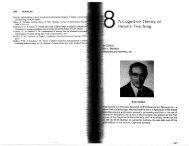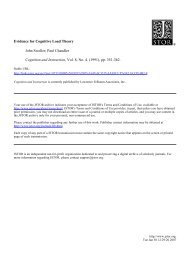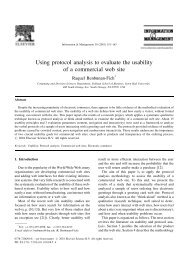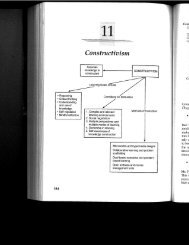a primer on verbal protocol analysis - Ammon Wiemers' Home Page
a primer on verbal protocol analysis - Ammon Wiemers' Home Page
a primer on verbal protocol analysis - Ammon Wiemers' Home Page
Create successful ePaper yourself
Turn your PDF publications into a flip-book with our unique Google optimized e-Paper software.
C35165/Schmorrow <strong>Page</strong> 337<br />
A Primer <strong>on</strong> Verbal Protocol Analysis 337<br />
amiss. Although this point may seem obvious, most researchers who collect <strong>verbal</strong><br />
<strong>protocol</strong>s have had the unhappy experience of reviewing a videotape <strong>on</strong>ly to<br />
find there is no sound. We hope to spare you that pain!<br />
As with any psychological research, participants should be oriented to the task<br />
before beginning the actual study. In the case of <strong>verbal</strong> <strong>protocol</strong>s, this orientati<strong>on</strong><br />
includes training in actually giving <strong>verbal</strong> <strong>protocol</strong>s. We have a standard training<br />
procedure that we use with all participants. 1 During the task, if a participant is<br />
silent for more than three or four sec<strong>on</strong>ds, it is important to jump in with a<br />
prompt. The researcher should simply say, “Please keep talking” or even “Keep<br />
talking.” More “polite” prompts, such as “What are you thinking” are actually<br />
detrimental, because they invite a more social resp<strong>on</strong>se from the participant (such<br />
as, “Well, I was just w<strong>on</strong>dering whether ...”) and thus remove the participant<br />
from the process of problem solving into the arena of social interacti<strong>on</strong>.<br />
Occasi<strong>on</strong>ally, a participant will be unable to provide a <strong>verbal</strong> <strong>protocol</strong>, and this<br />
difficulty generally manifests itself in <strong>on</strong>e of two ways: either the participant<br />
remains essentially silent throughout the task, talking aloud <strong>on</strong>ly when prompted<br />
and then lapsing back into silence, or the participant persists in explaining what<br />
he or she is doing or about to do. In the first case, there is very little the experimenter<br />
can do, and depending <strong>on</strong> the situati<strong>on</strong>, it may be better to bail out rather<br />
than subject the participant to this uncomfortable situati<strong>on</strong>, since the data will be<br />
unusable in any case. One way to help prevent this from happening is to ensure<br />
beforehand that participants are fully at ease in whatever language the <strong>protocol</strong><br />
is to be given. In the sec<strong>on</strong>d case, the experimenter must make a judgment call<br />
as to whether to pause the sessi<strong>on</strong> and provide some retraining. Retraining will<br />
be disruptive and may make the participant even more nervous; however, it is<br />
unlikely that a participant will change strategy midstream. In either case,<br />
<strong>protocol</strong>s that c<strong>on</strong>sist mostly of explanati<strong>on</strong>s cannot be used. These problems<br />
should not be c<strong>on</strong>fused with <strong>protocol</strong>s that c<strong>on</strong>tain a great deal of muttering, broken<br />
grammatical structures, or incomplete or incoherent thoughts. Although a<br />
challenge to the transcriber and the coder, such <strong>protocol</strong>s are quite acceptable<br />
and, in fact, represent “good” <strong>protocol</strong>s, since people rarely think in complete<br />
sentences.<br />
The objective during <strong>verbal</strong> <strong>protocol</strong> collecti<strong>on</strong> is to keep the participant<br />
focused <strong>on</strong> the task, without distracti<strong>on</strong>. One obvious way to do this is to make<br />
sure that the room in which the sessi<strong>on</strong> is taking place is not in a public place<br />
and that a sign <strong>on</strong> the door alerts others not to interrupt. Less obviously, it means<br />
that the experimenter should resist the urge to ask questi<strong>on</strong>s during the sessi<strong>on</strong>. If<br />
domain related questi<strong>on</strong>s do arise, the experimenter should make a note of them<br />
and ask after the sessi<strong>on</strong> is completed. Querying participants’ explicit knowledge<br />
after task completi<strong>on</strong> does not jeopardize the integrity of the <strong>verbal</strong> <strong>protocol</strong>s,<br />
because it taps into stable domain knowledge that is not altered by the retrospective<br />
process. Asking questi<strong>on</strong>s during problem solving, however, is disruptive,<br />
and may alter the participants’ cognitive processes.<br />
1 A copy of this procedure is available at http://www.nrl.navy.mil/aic/iss/aas/cog.complex.vis.php






